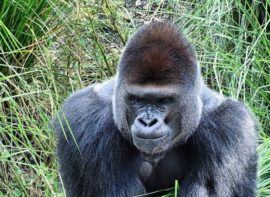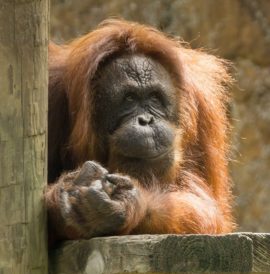Happy Great Ape Day! September 9 & 10
Written by: Tammy Buhrmester, Zookeeper
Did you know that there are six distinct species of great apes and that the Houston Zoo is home to three species?
Orangutans, gorillas and chimpanzees are members of the great ape family.
Is It a Monkey or an Ape?
One easy way to tell the difference between a monkey and an ape is to look for a tail. The great apes are tailless primates that have larger bodies and bigger brains than other primates.
The Social Lives of Great Apes
Gorillas live in “harem” groups (one adult male with several females and their offspring) of around five to ten individuals in a family group, although on occasion the group can be larger.
Chimpanzees live in multi-male, multi-female groups which can consist of a few dozen individuals, or more than one hundred. Chimp groups practice “fusion-fission” which means smaller subsets exist with the larger group and members come together and split apart depending on food availability and other factors.
Orangutans tend to live alone more than gorillas and chimpanzees. Adult females will travel with their offspring and recently have been found to also travel with another female and her offspring. Males and females only interact in order to produce an offspring.
The Houston Zoo Great Apes
At the Houston Zoo, we have 27 individual Great Apes; 7 gorillas, 14 chimpanzees and 6 orangutans.
 When you visit the Great Ape gallery in the Africa forest, you get the opportunity to be surrounded by chimpanzees and gorillas. When you watch the chimpanzee exhibit you may see Lucy sitting on her perch on the large termite mound watching over the group. You may catch Lulu sitting in front of the air conditioner in the training room. Willie our youngest male, may be in the yard playing a game of tag with Abe, Charlie, Kenya or Kira.
When you visit the Great Ape gallery in the Africa forest, you get the opportunity to be surrounded by chimpanzees and gorillas. When you watch the chimpanzee exhibit you may see Lucy sitting on her perch on the large termite mound watching over the group. You may catch Lulu sitting in front of the air conditioner in the training room. Willie our youngest male, may be in the yard playing a game of tag with Abe, Charlie, Kenya or Kira.
If you visit in the Great Ape Gallery in the morning, you will have the opportunity to see our gorilla family in their large indoor playroom. Zuri, our dominant male of the family group may be eating or resting with his large foot resting on the glass. Look up and you may see one of the three females sitting on the large tree or resting on the platform in the middle of the playroom. Binti, our oldest female normally is found resting on the ground the floor on the left side of the play room. We also have three amazing bachelor males that can be seen outside in the large yard. Mike usually can be found in the middle of the exhibit sitting under a tree and Chaka and Ajari are usually near each other.
When you visit the orangutan exhibit, you may see one or two orangutans on exhibit at the same time. Each day, the orangutans take turns out on the exhibit. They each get several hours a day outside. We vary the times that they go outside. Normally we rotate them at 9AM, 12PM and 3PM. Rudi Valentino prefers to go outside in the morning and Kelly likes to go out anytime of the day. Pumpkin loves to sit by the glass and look at everyone visiting. Cheyenne and Aurora usually can be found sitting around the platform at the front of the exhibit. Aurora loves to hang out on top of the platform, so if you don’t see anyone, look up and you might see her.
Take Action: Reduce, Reuse and Recycle
One of the major threats facing Great Apes is habitat loss and fragmentation. Habitat loss due to logging, mining, palm oil plantations and human encroachment has had a devastating impact on Great Ape populations.
On Great Ape Day, we encourage everyone to reduce the use of paper products by purchasing Forest Stewardship Council (FSC) certified wood, paper and furniture products. When you are grocery shopping, read labels and purchase only products that is made with sustainable palm oil or no palm oil product.
Great Ape Day will be celebrated at the Houston Zoo on Saturday and Sunday, September 9 and 10. Please stop by at the Africa Forest Great Ape gallery at 12:30PM to learn all about our chimpanzees and gorillas and at 3:30PM at the orangutan exhibit at the Wortham World of Primates to learn all about orangutans.
